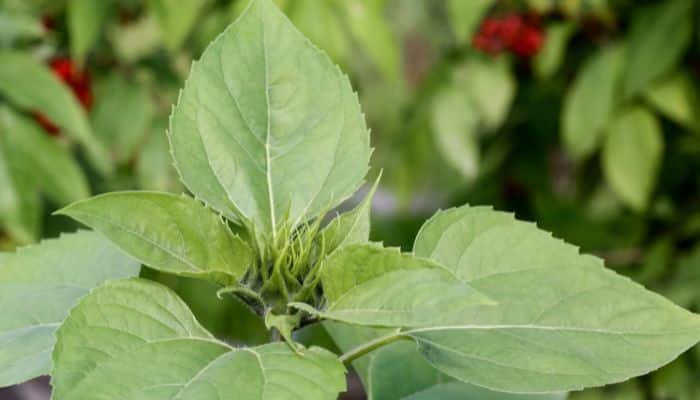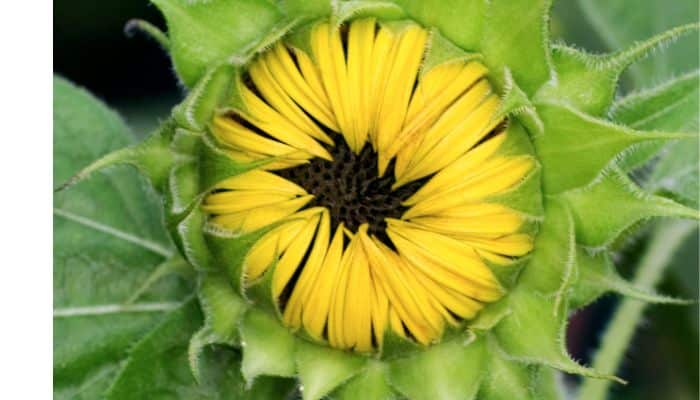Sunflower Growth Stages: sunflowers grow quickly, with many achieving up to 12 feet of growth in just 3 months. Under ideal growing conditions, sunflowers typically reach maturity within 70 to 100 days after planting.
The Life Cycle Of A Sunflower
Itions, and sunflower seeds can start to germinate within 7 to 10 days. During the germination stage, the seed absorbs water and begins to swell. Next comes the seedling stage, where the roots and cotyledons start to develop. In the vegetative stage, the sunflower plant grows leaves and stems.
Read More:
Once it reaches the reproductive stage, the sunflower starts to form buds, which eventually bloom into vibrant flowers. After the flowering stage, the plant enters the seed development stage, where the flowers turn into seed heads. Finally, during the harvesting stage, the sunflower seeds are ready to be harvested and used for various purposes.

Germination Stage: From Seed To Sprout
Germination is the first stage in the growth of sunflowers, starting from seed to sprout. Several factors can affect the germination process, such as seed preparation techniques and optimal conditions. Properly preparing the seeds, which may include scarification or soaking, can enhance germination rates.
Optimal conditions for germination include providing adequate moisture, temperature, and light. Sunflower seeds require moisture to soften the seed coat and initiate growth. They prefer a temperature range of 70-85°F (21-29°C) for optimal germination. While sunlight is not necessary for germination, providing indirect light can help the sprouts grow straight.
The germination stage is crucial in establishing healthy sunflower plants, as it sets the foundation for the rest of their growth and development. By understanding the factors that influence germination, gardeners can ensure successful sunflower growth.

Seedling Stage: Establishing Strong Roots
Sunflower seedlings go through the seedling stage, which is crucial for establishing strong roots. Characteristics of this stage include delicate stems and leaves, as well as a small size. Proper care and maintenance are essential for the healthy growth of seedlings.
This includes providing adequate sunlight, water, and nutrients. Transplanting seedlings into larger pots or outdoor gardens should be done carefully to avoid damaging the roots. It is important to monitor the development of seedlings and make adjustments to their growing conditions as needed.
By taking good care of seedlings during this stage, they will have a solid foundation for further growth and development.

Vegetative Stage: Leafy Growth And Development
Conditions, Sunflowers go through different growth stages. The vegetative stage is characterized by leafy growth and development. During this stage, sunflowers require specific nutrients and soil conditions for optimal growth. Farmers and gardeners need to manage pests and diseases that might affect sunflowers during this stage.
Proper pest control measures should be taken to ensure healthy plant development. Additionally, monitoring soil requirements, such as pH levels and moisture content, is essential for successful growth in the vegetative stage. By understanding the features of the vegetative stage, farmers and gardeners can provide the necessary care and support for sunflowers to reach their full potential.
Reproductive Stage: Preparing For Flowering
Sunflowers go through different growth stages as they prepare for flowering. The reproductive stage holds great significance in the overall growth of the plant. This stage is crucial for promoting optimal plant growth and ensuring successful flower production. One important aspect during this stage is pruning, which involves removing any dead or damaged leaves or branches to encourage healthy growth.
Supporting sunflowers is also necessary, as they tend to become top-heavy with the weight of their flowers. By using stakes or cages, the plants can be supported and protected from bending or breaking. Overall, proper care during the reproductive stage plays a vital role in ensuring that sunflowers reach their full potential and produce beautiful, vibrant flowers.

Flowering Stage: Colorful Blooms And Pollination
Sunflower growth stages are fascinating. During the flowering stage, colorful blooms appear and pollination takes place. This stage is crucial as it ensures the production of seeds. Pollination is essential for sunflowers to reproduce and produce a bountiful harvest. Supporting the sunflowers during the flowering stage is also important.
Staking or providing a trellis system can help prevent the tall stems from bending or breaking under the weight of the blooms. By properly supporting the sunflowers, gardeners can ensure that the flowers remain upright and healthy throughout the flowering stage.
Watching sunflowers go from bud to beautiful, vibrant blooms is a rewarding experience for any gardener. It’s incredible to witness the growth and transformation of these stunning plants.
Seed Development Stage: Maturing And Harvesting
Sunflower seeds for planting are a popular choice for many gardeners because of their vibrant blooms and easy cultivation. When it comes to the growth stages of sunflowers, the seed development stage is a crucial phase. Maturing and harvesting sunflower seeds requires understanding the characteristics of seed development.
Sunflowers typically take around 70-100 days to reach maturity, depending on the variety. During this time, the sunflower undergoes several growth stages, including germination, seedling establishment, vegetative growth, flowering, and seed development. Harvesting the sunflower seeds should be done when the back of the sunflower head turns yellow and the leaves start to dry out.
To store and use harvested seeds effectively, they should be properly dried and stored in a cool, dry place in airtight containers. Sunflower seeds can be used for various purposes, including culinary uses, and bird feed, or saved for planting in the next season.
Growing sunflowers can be a rewarding and enjoyable experience for any gardener.

Frequently Asked Questions On Sunflower Growth Stages
How Long Does Sunflower Take To Grow?
Sunflowers grow quickly and can reach up to 12 feet in only 3 months. They usually reach maturity in 70 to 100 days after planting.
What Are The 6 Stages Of A Sunflower?
Sunflowers go through 6 stages: germination, seedling, vegetative, budding, flowering, and seed production.
How Long Does It Take For A Sunflower To Fully Bloom?
Sunflowers can take 70 to 100 days to fully bloom, reaching a height of up to 12 feet in just 3 months.
What Is The Full Life Cycle Of A Sunflower?
Sunflowers grow quickly, reaching up to 12 feet in just 3 months. They mature in 70 to 100 days after planting.
How Long Does It Take For A Sunflower To Grow?
Sunflowers grow quickly. Many can achieve up to 12 feet of growth in only 3 months.
The last info
Sunflowers are known for their rapid growth and stunning beauty. With the right conditions, these vibrant flowers can reach up to 12 feet in just three months, making them a popular choice among gardeners. From seed to maturity, it typically takes sunflowers 70 to 100 days to complete their growth stages.
This timeline may vary depending on factors such as climate, soil quality, and watering practices. Whether you’re a seasoned gardener or new to cultivating sunflowers, understanding the growth stages is essential for successful plant care. From germination to the development of buds and blooming flowers, each stage is a testament to nature’s beauty and resilience.
By nurturing these stages with adequate sunlight, water, and nutrients, you can enjoy a bountiful garden filled with majestic sunflowers that brighten up any landscape.









